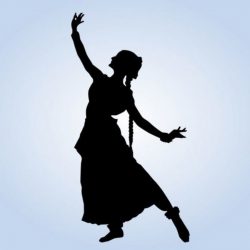This dance has no such historic evidence. Although many stories are famous for the start of this dance but as such there is no solid or written evidence that when this dance came in to existence. This dance regains its name around 1779s by the efforts of King Bhagyachandra Jai Singh. Manipur was the center where this dance was much often and in big scale performed that is why it named ‘Manipuri Dance’. It is folk as well as classical dance in Assam and east Bangal states of India.
This dance is generally performed in-group. Mostly religious or mythological stories or Krishna devoted poems are preferred in performance. Raslila is the specialty of this dance. Mostly in all festival of eastern India this Raslila is performed. This dance is the softest in all the classical dances of India. Girls perform this dance generally but boys may also take part in performance as well.
Dance start with soft and slow movement of the hand and the body. Whole body moves as sea waves. Hands vibrate as breeze makes the small petals of the flower move delicately. From high heels up in the air dancer stroke the toes with rhythm and move as water flow in a small river.
In Manipuri dance there are different types of Raslila which are performed on different occasions. (a) Vasant Ras (b) Maha Ras (c) Kunj Ras (d) Nitya Ras (e) Gop Ras (f) Ulukhal Ras (g) Diva Ras (h) Rakhal Ras etc. these all Ras are totally famine oriented and Lasya is the always dominant on this style.
As such there is no documentation about the hand movements or about the whole dance. This tradition is followed from the teacher to student mouth to mouth. As such in some of the area of Assam it is folk dance also and during the festival almost all the village may take part in the recital. ‘Lai Haroba’ is one of the prominent example of such dances. Movements and the gestures change from generation to generation. It is very rarely performed as solo dance.
Manipuri dance is famous for is costumes and outfits, which is very attractive and colourful. Such attractive costume and ornaments make this style special from other classical dance. Its costume itself a good example of creative art. Costume for females are called ‘Patloi’. It made of bright Satan or silk. This loose ‘Lahanga’ which is called ‘Kumin’. Small mirrors and golden ‘Zari’ and threads decorate this Kumin. This Kumin is kept like round drum shape with the help of thin lining of bamboo wood. On this girls wear transparent silk which is called ‘Peshwan’.
On the upper part of the body they wear ‘Choli’, which is also decorated in same way as Kumin. Hairs are kept as knot on the head, covered with some silver ornament. Head and face is covered by very thin and transparent silk. As this silk is very thin facial expression are quite visible. Eyes, eyebrow, cheeks, Fore head are decorated with bright colours. Pearl and silver ornaments or flower ornaments are used to decorate all over the body.
Radha wears mostly Green colour costume while other girls wears Red colour costume. Krishna wears orange and yellow cloths. As headwear, he wear crown from the peacock fan. On waist all wears belt glass decorated silver belt.
Some of the famous teachers of this style are Amobi Singh, Shanti Vardhan, Savita Behen (Mehta Didi), Vipin Singh, Tombo Devi and Jhaveri Sisters.

